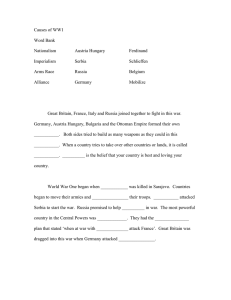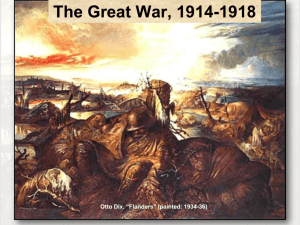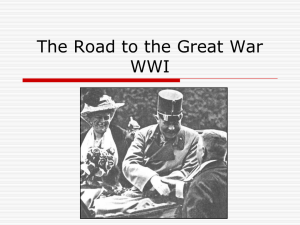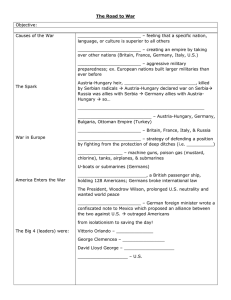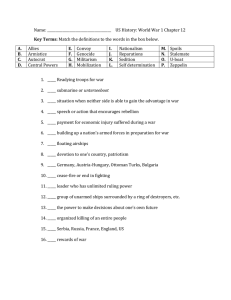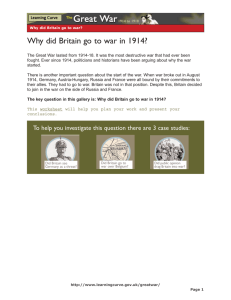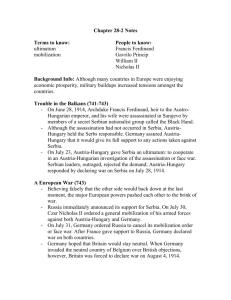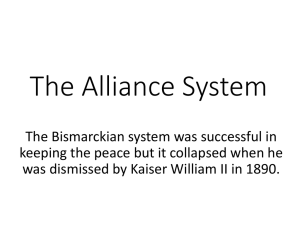alliance system PDF
advertisement
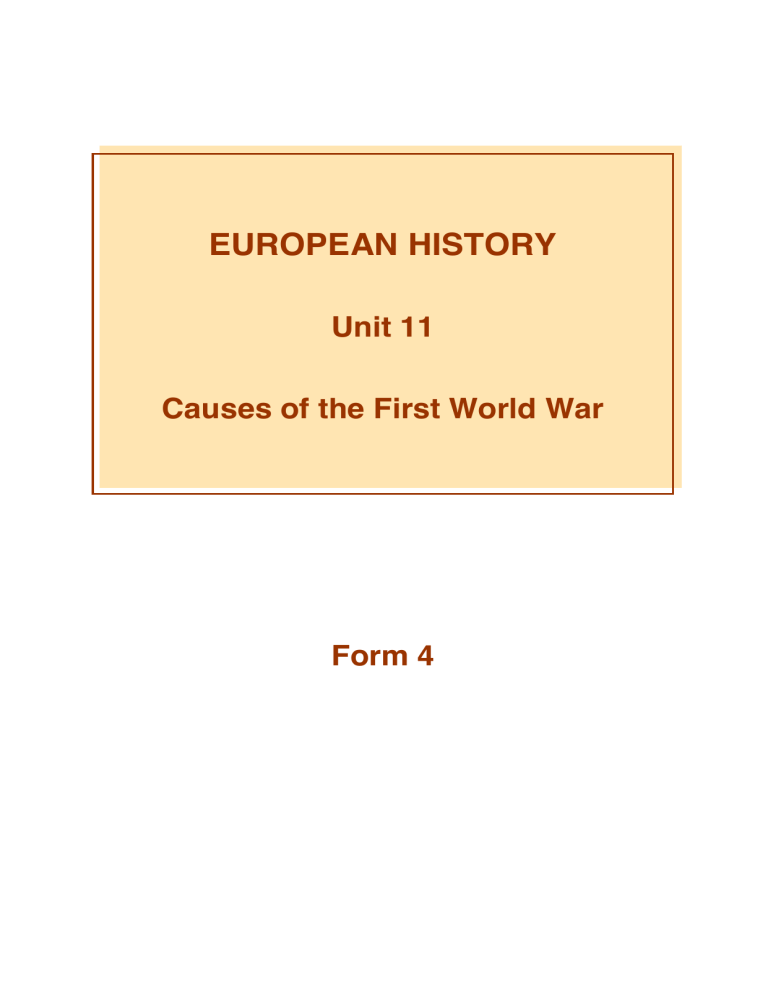
EUROPEAN HISTORY Unit 11 Causes of the First World War Form 4 1 Unit 11.1 The European Alliances System, 1871-1914 1. The situation of the Great Powers in 1871 Britain Germany, AustriaHungary and Russia France Italy The Ottoman Empire had no ties with other countries for it gave more importance to the building of her colonial empire. Britain was said to be in ‘splendid isolation’. These were tied to each other by an agreement called the Three Emperors League. had very few friends because she had been defeated by Prussia in 1871 (Franco-Prussian War) and it was still licking her wounds. Had just been united and it was still not strong enough. It was trying, however, to build up her army and her Mediterranean navy. Turkey was in rapid decline. It had lost most of her lands in the Balkan peninsula. By this time it was called ‘the sick man of Europe.’ 2. How the European Alliance came into being Agreement 1 1879 The Dual Alliance GERMANY AUSTRIA-HUNGARY Agreement 2 1882 The Triple Alliance GERMANY AUSTRIA-HUNGARY ITALY This three-way friendship worried France and Russia that they could be attacked by three powers acting together. So in 1892 they agreed to help each other if either of them was attacked. For a while, agreement no. 3 calmed their fear. But soon it was Britain’s turn to become worried. During the Boer War in South Africa, Germany showed sympathy with the Dutch Boers against the British. Britain started to mistrust Germany and looked for France for a friend in Europe. In 1903 King Edward VII visited France and signed the Entente Cordiale, meaning ‘Friendly Understanding’. This meant that Britain was no long in ‘splendid isolation’. Agreement 3 1892 The Franco-Russian Alliance FRANCE - RUSSIA Agreement 4 1904 The Entente Cordiale FRANCE - BRITAIN Agreement 5 1907 The Triple Entente FRANCE - BRITAIN - RUSSIA Three years later, Britain made a similar agreement with Russia who was already in alliance with France. So by 1907 the European Great Powers were grouped into two opposing armed camps. Alliance No 2 Alliance No.4 2 Alliance No.5 Unit 11.1 - The European Alliance System 1871-1914 1. Europe’s Alliances in 1914 3 Unit 11.2 Planning for War on Land and Sea 1. The Schlieffen Plan 2. German dreadnaughts 1. The German Schlieffen Plan In 1905 the German General Alfred von Schlieffen prepared a plan of how Germany could fight her enemies if a war broke out in Europe. His plan was aimed to avoid a war on two fronts. If war began, the whole German army should invade France by travel at high speed through neutral Belgium and capture Paris. Having defeated France in six weeks, the German army would then be sent in on the eastern front to fight the Russians. Although it was a simple plan, it actually made a war on two fronts even more likely. By attacking France first, Germany made certain that France would not remain neutral in a war between Germany and Russia. Schlieffen had made sure that any war fought by Germany would be a ‘European’ war. 2. The French Plan Seventeen The French had been planning a war of revenge against Germany. They made many plans. Finally, in 1913, General Joffre came up with Plan Seventeen – if war broke out, the French army would make an all-out attack on their lost provinces of Alsace-Lorraine. They would then cross the River Rhine and head for Berlin. Plan 17 relied also on high speed. 3. Other plans Britain, Russia and Austria-Hungary also had their war plans. Britain formed an Expeditionary Force whose task was to cross quickly to France as soon as war was declared. Russia started to build up her armies in 1909. Austria started making enormous cannons in their Skoda arms factory. By 1914, the rival alliances were armed to the teeth and ready to fight each other using detailed plans for high-speed attacks. What remained was the excuse to start a fight. 4. The Anglo-German Naval Race The naval race began when Kaiser William II wanted Germany to become a great world power. To achieve this, she needed a navy that challenged Britain’s largest navy in the world. Britain, however, was not prepared to allow this. She needed a large fleet to protect their colonies and her trade routes. So the British naval chiefs decided to enlarge the Royal Navy even more. The race began in 1900 when the German Navy Law ordered the building of 41 battleships and 60 cruisers. The German Naval League was set up to make the people more informed and interested in the navy. Britain responded by building a new type of battleship called Dreadnought. She was faster, had thicker armoured plates and fired within a range of 32 km. 4 Unit 11.3 Two Tests of Strength – The Moroccan Crises 1. The Kaiser 4. An Entente Cordiale Poster 2. Sultan Abdulaziz 3. Sultan Andulmehid 5. The German Panther at Agadir, 1911 1. The Tangier Crisis, 1905 In 1905 the French were getting ready to make Morocco into one of their colonies. Kaiser William opposed this and went personally to Tangier to promise the Sultan of Morocco against a French attack. As the news spread all over Europe, people wondered whether it would lead to war between Germany and France. For several weeks there was tension in Europe, until in the end they decided against war. Instead they decided to hold a conference in the Spanish town of Algericas. The conference was a great disappointment for the Kaiser. France gained special rights in Morocco, but that country remained independent. But the Kaiser found out want he wanted to know – that Britain and France would support each other by diplomacy, but would not join together to fight a war against Germany. 2. The Agadir Crisis, 1911 Five years later, the Kaiser interfered again in the affairs of Morocco. In 1911 Moroccan rebels attacked the town of Fez. The French government sent an army to help the sultan drive them out. William accused the French of invading Morocco and so he send a German warship to the Moroccan port of Agadir. Britain feared Germany would turn Agadir into a German naval base close to Gibraltar. The Royal Navy was made ready for war. This time it seemed that there would be war between Germany and Britain. At the last moment, the Kaiser gave way and ordered the German warships to leave Agadir. War was avoided but the incident scared both Britain and France. One result of this crisis was that the race to build breadnoughts became even more frantic. Both countries prepared themselves for the next confrontation. 5 Unit 11.4 The Balkan Problems 1. How the Great Powers became involved in the Balkans 2 an 3. Poster of the First Balkan War, 1912 1.The Crisis over Bosnia-Herzegovina, 1908 The powerful countries surrounding the Balkan Peninsula (Russia, Austria-Hungary, Italy) were all interested in what was going on in Turkey. They could take advantage of Turkey’s weakness to grab land and increase their influence in that area. The chance to do so came suddenly in 1908. In that year the Young Turk Revolution broke out in Turkey. A group of army officers took control of the government in Constantinople and forced the sultan to grant a liberal constitution. On hearing of what happened in Turkey, the King of Bulgaria declared his country independent from Turkey. The people of Crete broke away from Turkey and united with Greece. But it was Austria-Hungary that took the most advantage by seizing the provinces of Bosnia-Herzegovina from Turkey and joined it with Austria-Hungary. But this turned out to be a fatal mistake – the people of these provinces were mostly Serbs who wanted to unite with Serbia not with AustriaHungary. This development was to bring more trouble in the Balkans, this time between Serbia and AustriaHungary. 2.The Balkan Wars, 1912-1913 After the Young Turk Revolution, Turkey grew more and more weak. The Balkan countries now saw a chance to drive out the Turks out of Europe. In 1912 the Kings of Greece, Bulgaria, Serbia and Montenegro joined together in the Balkan League and attacked Turkey. The First Balkan War was cruel and costly. The League proved stronger and after only 50 days of fighting Turkey surrendered. Turkey gave up their remaining lands in the Balkans and these were shared between the four victors. A new country, Albania was created. But now the four kings of the League quarrelled about their share of the land. This quarrel brought about the Second Balkan War in 1913. Serbia, Montenegro, Greece, Romania and Turkey joined against Bulgaria which was attacked from four sides. The country which came out best from the two Balkan Wars was Serbia. King Peter of Serbia had doubled the size of his country and his people. The Serbs living in Bosnia-Hezegovina became restless and wanted more than ever before to unite with Serbia. The Austrians became even more worried that these people would rebel. 6 Unit 11.5 The Sarajevo Murders, 28th June 1914 1. The last living moments of Archduke Franz Ferdinand and his wife Sophie, 28 th June 1914. 1. The Black Hand In 1911, in Belgrade, the Serbian capital, ten young army officers founded a secret society named Unity or Death, more commonly called The Black Hand. Their aim was to unite all the Slav peoples in the Balkans into a single country called Yugoslavia. They made sure that frontier guards on the border between Bosnia and Serbia were Black Hand members. Once in Bosnia, Black Hand terrorists would plant bombs or shoot enemies and slip safely back into Serbia. The Austrians were outraged and feared that the Black Hand would start a rebellion in Bosnia. In this tense situation the Austrian Government made a foolish decision. They announced in the newspapers that the heir to the throne, Archduke Franz Ferdinand, would visit Bosnia in June 1914 to watch army exercises and go to Bosnia’s capital Sarajevo. The Black Hand made plans to murder the archduke. Three weeks before the visit, Gavrillo Princip, 19 years old, and two other students slipped to Bosnia and went to Sarajevo. 2. The Archduke’s visit and murder at Sarajevo. 28th June 1914 Franz Ferdinand and his wife Sophie arrived at Sarajevo railway station at 9.30 am. They travelled in an open-topped car to the Town Hall. Crowds lined the streets. The Black Hand terrorists were in the crowd waiting for the right moment to act. As the car approached, one of them stepped forward and threw a bomb at it. Ferdinand managed to deflect it into the road where it exploded under the car behind. Ferdinand became furious and the town mayor decided to cancel the rest of the visit. On the way back to the railway station, the chauffeur took a wrong turning. Quite by chance, Princip was standing in that very street. As the chauffeur reversed, Princip stepped forward and fired two pistol shots. One bullet hit the Archduke in the throat, the other hit Sophie in the stomach. The royal couple died a few minutes later in the Governor’s palace. Princip tried to commit suicide by swallowing poison, but it failed to work. He was arrested, questioned and beaten up by the police. He was later tried and hanged by the Austrians. 2. Colonel Apis, founder of the Black Hand 3. The arrest of Gavrilo Princip moments after the Sarajevo murders 7 Unit 11.6 - The Countdown to War 1. The results of the Sarajevo murders The Sarajevo murders led directly to another war in the Balkans. The Austrian Government decided to teach the Serbs a lesson for secretly helping the Black Hand. The Austrian Government sent a long telegram to King Peter of Serbia, saying: ‘The Sarajevo assassinations were planned in Belgrade, the arms and explosives…were given to them by Serbian officers…and the passage into Bosnia of the criminals and their arms was organised by the chief of the Serbian frontier service…’ ‘The Austro-Hungarian Government expects the reply of the Royal Government at the latest by 6 o’clock on Saturday the 25th July.’ King Peter had 48 hours to make up his mind and send a reply. The telegram was an ultimatum, or final demand. If he did not agree to its demands, Austrian forces would invade his country. Shortly before the time expired, King Peter replied. He agreed to do all the Austrians demanded, but with one big exception: he would not allow Austrian officials into Serbia for that would mean the end of Serbia’s independence. When they received the reply, the Austrian Government declared war on Serbia and the next day Austrian cannons bombarded Belgrade. The Serbian Government then asked Russia for help because the Russians were Slavs like the Serbs. So on 29 th July, Tsar Nicholas II ordered the Russian army to prepare for war to help Serbia against Austria-Hungary. His order started a countdown to the biggest war the world had ever known. 2. The countdown to war 6 days to war Thursday 30th July When Kaiser William heard that the Russian army was preparing for war, he sent an ultimatum to Tsar Nicholas, ordering him to stop. Nicholas refused and so Germany declared 4 days to war war on Russia. As France was an ally of Russia, the French Saturday Government ordered the mobilization of the 1st August French army and declared war on Germany. The Kaiser ordered France to stop its 3 days to war mobilization. When it refused, Germany declared war on France and started putting Sunday into practice the Schlieffen Plan by invading 2nd August neutral Belgium. 2 days to war Monday 3rd August The British Government honoured their promise to protect the neutrality of Belgium. It sent an ultimatum to the Kaiser ordering him to call back his army. 1 day to war Tuesday 4th August That evening, British politicians sat in the Cabinet room waiting for an answer. But no answer came from Berlin. That night Britain declared war on Germany. Five of the Great Powers of Europe were 0 days to war now at war with each other: the Central Powers (Germany and Austria-Hungary) Wednesday against the Entente or Allied Powers 5th August (Britain, France and Russia). 8 In 1915 and 1916 the war in Europe continued to spread as more countries joined the Central Powers and the Triple Entente (see map above). By 1915 there were to main fronts were the most fighting took place: the Western and the Eastern Fronts. Unit 11.1 – 11.6 The Causes of the First World War (1) 1. Use different colours to match the three columns together. (5) a Germany and Austria-Hungary The Triple Alliance 1892 b France and Russia The Entente Cordiale 1904 c Germany, Austria-Hungary and Italy The Dual Alliance 1879 d France, Russia and Britain The Triple Entente 1907 e Britain and France The Franco-Russian/Dual Alliance 1882 2. During the First World War the alliance made up of Germany, Austria-Hungary and Italy were referred to as the ________________ Powers, while that of Britain, France and Russia became known as the _______________ Powers. (2) 3. (a) Which Great Power came up with the Schlieffen Plan? _____________________________ (1) (b) What was the main plan of this plan? _________________________________________________________________________ (1) 4. (a) What was the main aim of France’s Plan Seventeen? ________________________________________________________________________ (1) 5. (a) Name the Great Powers that were involved in a naval race in the early 20th century. _________________________________ __________________________________ (2) (b) Why was there a naval race between these two powers? _________________________________________________________________________ _________________________________________________________________________ 6. The Tangier and Agadir Crises are also known as the ____________________ Crises (2) (1) 7. These two crises were mainly a test of strength between ______________ and _____________ (2) (a) Which of these Great Power came out as the loser and why? ________________________ __________________________________________________________________________ (2) 8. The Balkan Problem is also referred to by historians as the Eastern Question. What was the main cause of this problem? ____________________________________________________________________________ (2) 10. How did the Turkish nationalists try to stop the decline of the Ottoman Empire in 1908? ___________________________________________________________________________ 9 (2) 9. Match the aims of the Great Powers during their involvement in the Eastern Question: a Austria-Hungary to extend her influence over the Turkish Empire. b Germany to stop Serbia from becoming stronger in the Balkans. c Russia to preserve the balance of power in the Balkans. d Britain to annex Albania and extend its influence in the Adriatic. e Italy to annex Constantinople and obtain a Mediterranean seaport for its Black Sea fleet. (5) 11. Why did the Bosnian Crisis of 1908 lead to greater tension in the Balkans? ___________________________________________________________________________ (2) 12. What was the aim of: (a) the First Balkan War of 1912? ______________________________________________ ________________________________________________________________________ (b) the Second Balkan War of 1913? (1) __________________________________________ ________________________________________________________________________ (1) 13. (a) What was the Black Hand? ________________________________________________ (1) (b) Why was it founded? _____________________________________________________ (1) 14. Which did it accomplish in June 1914? __________________________________________ __________________________________________________________________________ (1) 15. What direct consequence did this bring: (a) upon Serbia in July 1914? _________________________________________________ _______________________________________________________________________ (b) upon Europe in August 1914? (1) _____________________________________________ _______________________________________________________________________ (1) 16. Explain the meaning of the term ‘mobilization’ in the context of the events of the summer of 1914. ___________________________________________________________________________ (1) 17. Who do you think was to blame for the outbreak of the Great War of 1914: Austria-Hungary, Serbia, Germany or Russia? Give a reason for your answer. ___________________________________________________________________________ ___________________________________________________________________________ (2) (Total Marks: 40) 10 Unit 11.1 – 11.6 The Causes of the First World War (2) N.B. You need to re-read pages 2 to 8 in order to be able to answer the following exercise. (b) In Column A: Fill in these causes for the outbreak of World War I, starting with the one that you think was the most important causes and ending with the least important cause. (c) In Column B explain how each cause contributed to the outbreak of the war. List of causes to rearrange in order of importance in Column A. The System of Alliances The Moroccan Crises The Bosnian Crisis of 1908 Kaiser William II of Germany The Assassination at Sarajevo The Balkan Wars of 1912-1913 The Naval Race The Austro-Hungarian ultimatum to Serbia The Schlieffen Plan The invention of more deadly weapons Column A List of Causes of World War I Explanation of each cause 1 2 3 4 5 6 7 8 9 10 11 Unit 11. 7 - Origins of the First World War 1. The year 1871 marked a turning point in the diplomatic relations between the ____________ Powers of Europe. 2. The defeat of ________________ by Prussia in 1871 left her isolated while ____________ was more concerned with colonial problems and internal social reform. 3. After 1871 Chancellor Bismarck started building up a system of ___________ to keep Germany dominant in Europe and keep _____________ without allies. 4. In 1893 the France and Russia formed the ____________ Alliance against the ______________ Alliance made up of Austria-Hungary, Germany and Italy. 5. Once the Franco-Russian Alliance came into being, ________________ would be forced to fight a war on two fronts at the same time. 6. A __________ race then developed between Britain and Germany over which one of them was to have the largest and most powerful navy. 7. In 1904 ______________ abandoned her former policy of splendid isolation when she signed the Entente Cordiale with France in 1904. 8. The two _________________ Crises of 1905 and 1911 nearly brought war between France and Germany. 9. In 1907 Britain, France and Russia signed the ______________ Entente to defend themselves in a future war against the Triple Alliance. 10. The Young Turk Revolution of 1908 made the Balkan peoples more determined to break away from the _________________ Empire. 11. Austria-Hungary annexed _______________________ in 1908, a land which Serbia wanted for herself to create a larger Slav state called Yugoslavia. 12. The incident that brought war between Austria-Hungary and ______________ was the assassination of Archduke Franz Ferdinand at ______________ on 28 th June 1914. 13. When Austria-Hungary declared war on Serbia on 28 th July 1914, France and Russia supported Serbia while ________________ supported Austria-Hungary. 14. Britain declared war on Germany when Germany invaded neutral _______________ as part of the German _______________ Plan to defeat France. 15. By 3rd August 1914 the five Great Powers had entered the war on two opposing blocs, with the exception of ____________ and Turkey which joined in the war in 1915. (Total 20 marks) 12 Unit 11. 8 - Origins of the First World War – Essay Questions Read carefully the following essay titles and answer any ONE in about 200 to 300 words. Essays carry 20 marks each. PAPER 2A 1. Explain the reasons why the Great Powers of Europe went to war in 1914? (Oxford GCE) 2. ‘By 1907 Europe was divided into two armed camps.’ Why was this so? What was the consequence of this division? (Oxford GCE) 3. Identify the European alliances and alignments that preceded the First World War. Explain why they led to war. (SEC 2010) PAPER 2B 1. (a) What were the main reasons for the outbreak of the First World War? (12) (b) What were the main provisions of the resulting peace treaty? (8) (SEC 2009) 13
